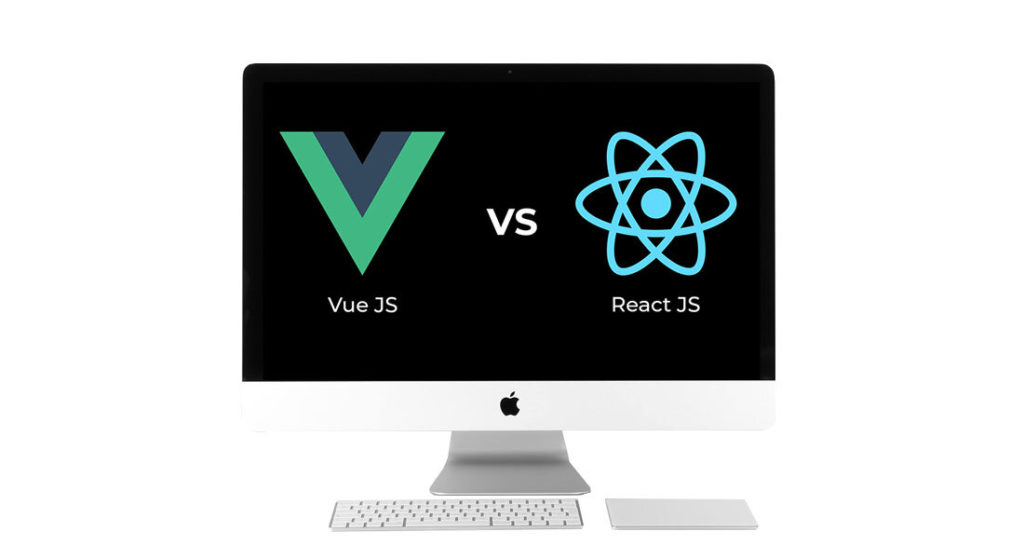Javascript is one of the prevailing languages of the web and its popularity is continuously growing. Many javascript framework are coming out every year and we are continuously witnessing fierce and exciting challenges and comparisons among the emerging frameworks. Choosing the right javascript can always be challenging and it is one of the most critical and important steps toward the success of your web project.
React and Vue can be considered as a leading and popular javascript framework in the world. Both frameworks provide the developers with an efficient tool to build their web applications. Both frameworks have their own merits and they can respond to different business requirements. So we will articulate the merits and demerits of both frameworks along with market trends and insights which provides more clarity about the frameworks and thus compare them more effectively to find the most favourable one.

The question, then, arises: Which one to pick for your next web development project?
History of javascript framework
React is an open-source javascript library developed in 2013 by Facebook for building interactive user interfaces. React has backing by this tech giant. This ensures the stability of React and they also receive long term support from Facebook.
Vue is the youngest member of the javascript framework. It is developed in 2014 by the ex-google employee named Evan. It started with a vision to create a framework that combined the features of popular frameworks like react, angular, and ember. Vue has gained much popularity through these years even though it is not backed by any large companies.
Similarities of javascript framework
Before going to the differences between the 2 frameworks, we will look into the similarities between them
- The most significant common trait is Virtual-DOM. In the case of regular DOM, there is a re-rendering of the whole page. React and Vue uses the virtual DOM and thus update only those objects that have changed.
- React and Vue are lightweight. They have a component-based architecture that has considerable libraries which promotes code reuse, improve developer productivity, and speed up the development process.
- Both support libraries used for building mobile applications
Differences
Code Style:
React relies on JavaScript XML popularly known as JSX which is a means of adding HTML code within the javascript. Everything within the React environment is treated as a single component by the javascript framework. The component lifecycle offers a way of attaching specific lifecycle events like updates, creation, etc. The XML-like syntax grants building self-contained UI components with view-rendering instructions.

Coding in Vue is similar to that in Angular but it gets rid of the demerits of Angular. Vue is way much easier to learn when compared to React. Vue decouples JavaScript, HTML, and CSS which helps the developers to create web applications easily and also allows you to use JSX. Vue doesn’t force you to change your coding style.
Learning Curve:
The official React documentation to act as a guide for developers who have some experience in front end framework. React is not a complete framework. It is dependent on other third-party components for effective use. It demands a lot of time and effort even for an experienced developer. The developer needs to have a good understanding of js libraries.
One of the most fascinating aspects of Vue is that it is much easier for a JS developer to follow the framework and work with it. The documentation of Vue is well written and covers everything required.
Flexibility:
State management is one of the important features. Hence Vue and React pay close attention to state management and data flow since there are a number of units interacting with each other and sharing data.
React is best for building user interfaces. It focuses on the essential things related to the user experience. Most of the React applications adopt Redux, which is an open-source JavaScript library for managing application state, for state management. Mobx, which is a library that makes state management simple and scalable, is also gaining major attention these days.
Vue is also considered as a flexible javascript framework. It provides all those elements for building an app and also provides bonus features like
- Vuex for state management
- Vue Router for routing
- Vue Server-Side Renderer for Server-Side Rendering
Popularity:
According to NPM, React has been a leader in popularity among all other JavaScript frameworks. The downloads of the react package have crossed 330 million and the downloads of Vue package have crossed 66 million from June 2019 to June 2020. Stack overflow trends present React at the top position. Another insight we get is the rising popularity of Vue over these years. Stack overflow gives this data based on all the questions received from developers and it is seen that there is a considerable increase in the queries related to Vue after React. GitHub also gives the impression of Vue as a highly rated framework after React and React has the most Fork and view rates, but Vue has the most stars.
Performance:
Performance is an important feature to be considered for front end applications. On assessing the overall performance of frameworks, DOM(Document Object Model) is considered the User Interface of any application. When compared to React, Vue has the best approach to update HTML files. React has gained fame for its incredible speed but Vue is also an exceptionally fast tool. Both Vue and React utilize Virtual DOM. Vue delivers high performance and memory allocation and helps to overcome the difficulties faced in using React and other frameworks.

Talent Hiring:
Since react has been backed by Facebook, it has gained popularity since its beginning. Even though Vue is easier to learn when compared to React, there are a significantly large number of React developers in the market than Vue developers. Hiring a React developer is the best option when there is a need for complex applications in a business environment and also considering the fact that there are more projects utilizing React than Vue. According to many sources like LinkedIn, glassdoor and Indeed, React developers have more demand or job offers than the Vue developers.
React is way much ahead of Vue in case of the opportunities but Vue is young and growing and as time passes it may attain more popularity and provide higher competition to React.
Apps built with React




Netflix

Uber


Apps built with Vue

9gag

Gitlab

Behance

Alibaba

Grammarly
Summary
When you want to make a choice between the Javascript framework- Vue and React, it comes down to your business requirements. React is the most popular and leading player in the industry. It is treated as the trendsetter and is a highly demanded skill. Many javascript framework have tried their best to get the name and fame but failed except Vue which has attracted developers recently. Vue in spite of being a freshman, it has managed to stay along with React due to its special qualities like performance, simple to learn, the flexible and complete package. React is chosen for complex apps with the motive to expand it in the future. You should go with Vue if you need a simple and light-weighted app.
